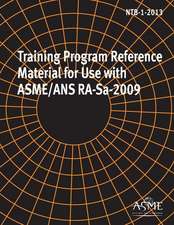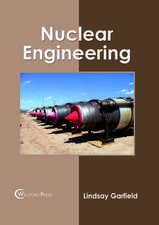Thermal-Hydraulic Analysis of Nuclear Reactors
Autor Bahman Zohurien Limba Engleză Paperback – aug 2018
Written in a lucid, straight-forward style while retaining scientific rigor, the content is accessible to upper division undergraduate students and aimed at practicing engineers in nuclear power facilities and engineering scientists and technicians in industry, academic research groups, and national laboratories. The book is also a valuable resource for students and faculty in various engineering programs concerned with nuclear reactors.
| Toate formatele și edițiile | Preț | Express |
|---|---|---|
| Paperback (1) | 1679.11 lei 6-8 săpt. | |
| Springer International Publishing – aug 2018 | 1679.11 lei 6-8 săpt. | |
| Hardback (1) | 1685.72 lei 6-8 săpt. | |
| Springer International Publishing – 7 iun 2017 | 1685.72 lei 6-8 săpt. |
Preț: 1679.11 lei
Preț vechi: 2047.69 lei
-18% Nou
Puncte Express: 2519
Preț estimativ în valută:
321.28€ • 335.48$ • 265.31£
321.28€ • 335.48$ • 265.31£
Carte tipărită la comandă
Livrare economică 15-29 aprilie
Preluare comenzi: 021 569.72.76
Specificații
ISBN-13: 9783319852515
ISBN-10: 3319852515
Ilustrații: XXVIII, 835 p. 453 illus., 173 illus. in color.
Dimensiuni: 155 x 235 mm
Greutate: 1.18 kg
Ediția:Softcover reprint of the original 2nd ed. 2017
Editura: Springer International Publishing
Colecția Springer
Locul publicării:Cham, Switzerland
ISBN-10: 3319852515
Ilustrații: XXVIII, 835 p. 453 illus., 173 illus. in color.
Dimensiuni: 155 x 235 mm
Greutate: 1.18 kg
Ediția:Softcover reprint of the original 2nd ed. 2017
Editura: Springer International Publishing
Colecția Springer
Locul publicării:Cham, Switzerland
Cuprins
An Introduction to Thermal Hydraulic Aspects of Nuclear Power Reactors.- Thermodynamics.- Transport Properties.- General Conservation Equations.- Laminar Incompressible Forced Convection.- Turbulent Forced Convection.- Compressible Flow.- Conduction Heat Transfer.- Forced Convection Heat Transfer.- Natural or Free Convection.- Mass Transfer.- Thermal Radiation.- Multi-Phase Flow Dynamics.- Convective Boiling.- Thermal Stress.- Combined Cycle Driven Efficiency in Nuclear Power Plant.- Heat Exchangers.- Analysis of Reactor Accident.- Probabilistic Risk Assessment.- Nuclear Power Plants.- Nuclear Fuel Cycle.- The Economic Future of Nuclear Power.- Safety, Waste Disposal, Containment, and Accidentss.- Appendix A: Table and Graphs Compilations.- Appendix B: Physical Property Tables.- Appendix C: Units, Dimensions and Conversion Factors.- Appendix D: Physical Properties.- Appendix E: Fluid Property Data.- Appendix F: Basic Equations.- Index.
Notă biografică
Dr. Bahman Zohuri is currently at the Galaxy Advanced Engineering, Inc. a consulting company that he stared himself in 1991 when he left both semiconductor and defense industries after many years working as a chief scientist. After graduating from University of Illinois in field of Physics and Applied Mathematics, he joined Westinghouse Electric Corporation where he performed thermal hydraulic analysis and natural circulation for Inherent Shutdown Heat Removal System (ISHRS) in the core of a Liquid Metal Fast Breeder Reactor (LMFBR) as a secondary fully inherent shut system for secondary loop heat exchange. All these designs were used for Nuclear Safety and Reliability Engineering for Self-Actuated Shutdown System. He designed the Mercury Heat Pipe and Electromagnetic Pumps for Large Pool Concepts of LMFBR for heat rejection purpose for this reactor around 1978 where he received a patent for it. He later on was transferred to defense division of Westinghouse where he was responsible for the dynamic analysis and method of launch and handling of MX missile out of canister. The results are applied to MX launch seal performance and muzzle blast phenomena analysis (i.e. missile vibration and hydrodynamic shock formation). He also was involved in analytical calculation and computation in the study of Nonlinear Ion Wave in Rarefying Plasma. The results are applied to the propagation of "Soliton Wave" and the resulting charge collector traces, in the rarefactions characteristic of the corona of the a laser irradiated target pellet. As part of his graduate research work at Argonne National Laboratory, he performed computation and programming of multi-exchange integral in surface physics and solid state physics. He holds different patent in areas such as diffusion processes and design of diffusion furnace while he was senior process engineer working for different semiconductor industries such as Intel, Varian, and National Semiconductor corporations. Later on he joined Lockheed Missile and Aerospace Corporation as Senior Chief Scientist and was responsible Research and Development (R&D) and the study of vulnerability, survivability and both radiation and laser hardening of different components Strategic Defense Initiative known as Star Wars. This included of payload (i.e. IR Sensor) for Defense Support Program (DSP), Boost Surveillance and Tracking Satellite (BSTS) and Space Surveillance and Tracking Satellite (SSTS) against laser or nuclear threat. While in there, he also studied and performed the analysis of characteristics of laser beam and nuclear radiation interaction with materials, Transient Radiation Effects in Electronics (TREE), Electromagnetic Pulse (EMP), System Generated Electromagnetic Pulse (SGEMP), Single-Event Upset (SEU), Blast and, Thermo-mechanical, hardness assurance, maintenance, device technology.
He did few years of consulting under his company Galaxy Advanced Engineering with Sandia National Laboratories(SNL), where he was supporting development of operational hazard assessments for the Air Force Safety Center (AFSC) in connection with other interest parties. Intended use of the results was their eventual inclusion in Air Force Instructions (AFIs) specifically issued for Directed Energy Weapons (DEW) operational safety. He completed the first version of a comprehensive library of detailed laser tools for Airborne Laser (ABL), Advanced Tactical Laser (ATL), Tactical High Energy Laser (THEL), Mobile/Tactical High Energy Laser (M-THEL), etc.
He also was responsible on SDI computer programs involved with Battle Management C3 and artificial Intelligent, and autonomous system. He is author few publications and holds various patents such as Laser Activated Radioactive Decay and Results of Thru-Bulkhead Initiation.
Recently he has published over 24 other books with Springer Publishing Company, CRC, and Francis Taylor on different subjects that they can be, found on Amazon.
He did few years of consulting under his company Galaxy Advanced Engineering with Sandia National Laboratories(SNL), where he was supporting development of operational hazard assessments for the Air Force Safety Center (AFSC) in connection with other interest parties. Intended use of the results was their eventual inclusion in Air Force Instructions (AFIs) specifically issued for Directed Energy Weapons (DEW) operational safety. He completed the first version of a comprehensive library of detailed laser tools for Airborne Laser (ABL), Advanced Tactical Laser (ATL), Tactical High Energy Laser (THEL), Mobile/Tactical High Energy Laser (M-THEL), etc.
He also was responsible on SDI computer programs involved with Battle Management C3 and artificial Intelligent, and autonomous system. He is author few publications and holds various patents such as Laser Activated Radioactive Decay and Results of Thru-Bulkhead Initiation.
Recently he has published over 24 other books with Springer Publishing Company, CRC, and Francis Taylor on different subjects that they can be, found on Amazon.
Textul de pe ultima copertă
This revised text covers the fundamentals of thermodynamics required to understand electrical power generation systems and the application of these principles to nuclear reactor power plant systems. The book begins with fundamental definitions of units and dimensions, thermodynamic variables and the Laws of Thermodynamics progressing to sections on specific applications of the Brayton and Rankine cycles for power generation and projected reactor systems design issues. It is not a traditional general thermodynamics text, per se, but a practical thermodynamics volume intended to explain the fundamentals and apply them to the challenges facing actual nuclear power plants systems, where thermal hydraulics comes to play. There have been significant new findings for intercooled systems since the previous edition published and they will be included in this volume. New technology plans for using a Nuclear Air-Brayton as a storage system for a low carbon grid are presented along withupdated component sizes and performance criteria for Small Modular Reactors.
Written in a lucid, straight-forward style while retaining scientific rigor, the content is accessible to upper division undergraduate students and aimed at practicing engineers in nuclear power facilities and engineering scientists and technicians in industry, academic research groups, and national laboratories. The book is also a valuable resource for students and faculty in various engineering programs concerned with nuclear reactors.
•Provides extensive coverage of thermal hydraulics with thermodynamics in nuclear reactors, from fundamentals to applications;
•Reinforces fundamentals of fluid dynamics and heat transfer; thermal and hydraulic analysis of nuclear reactors, two-phase flow and boiling, compressible flow, stress analysis and energy conversion methods;
•Includes detailed appendices that cover metric and English system units and conversions, detailed steam and gas tables, heat transfer properties and nuclear reactor system descriptions.
•Reinforces fundamentals of fluid dynamics and heat transfer; thermal and hydraulic analysis of nuclear reactors, two-phase flow and boiling, compressible flow, stress analysis and energy conversion methods;
•Includes detailed appendices that cover metric and English system units and conversions, detailed steam and gas tables, heat transfer properties and nuclear reactor system descriptions.
Caracteristici
Provides extensive coverage of thermal hydraulics with thermodynamics in nuclear reactors, from fundamentals to applications; Reinforces fundamentals of fluid dynamics and heat transfer; thermal and hydraulic analysis of nuclear reactors, two-phase flow and boiling, compressible flow, stress analysis and energy conversion methods; Includes detailed appendices that cover metric and English system units and conversions, detailed steam and gas tables, heat transfer properties and nuclear reactor system descriptions.






























